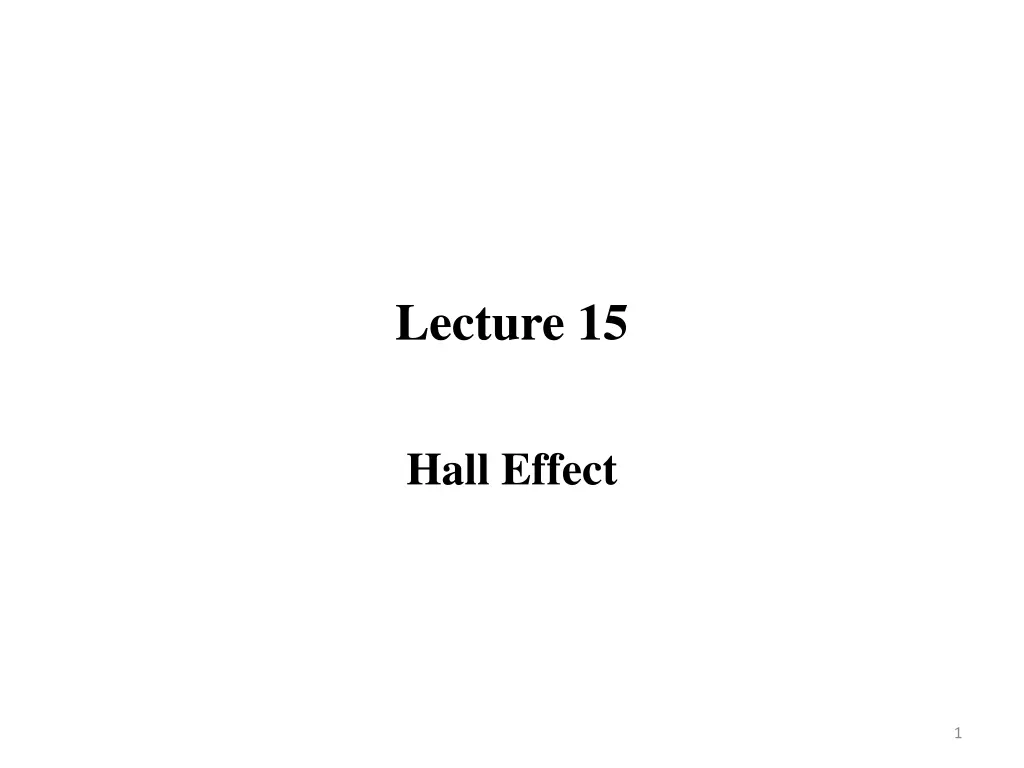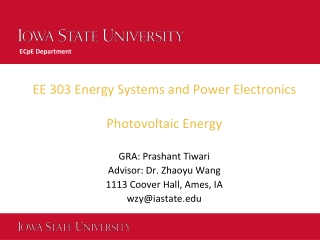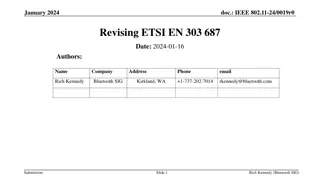
Understanding Hall Effect in Semiconductors
Explore the Hall Effect phenomenon in semiconductors, where charge carriers experience a force in a magnetic field, leading to the generation of a Hall voltage. Learn how this effect helps identify semiconductor types and impacts current flow direction.
Download Presentation

Please find below an Image/Link to download the presentation.
The content on the website is provided AS IS for your information and personal use only. It may not be sold, licensed, or shared on other websites without obtaining consent from the author. If you encounter any issues during the download, it is possible that the publisher has removed the file from their server.
You are allowed to download the files provided on this website for personal or commercial use, subject to the condition that they are used lawfully. All files are the property of their respective owners.
The content on the website is provided AS IS for your information and personal use only. It may not be sold, licensed, or shared on other websites without obtaining consent from the author.
E N D
Presentation Transcript
Lecture 15 Hall Effect 1
Recap The forward bias reduces the potential barrier of the diode and establishes the easy path for the flow of current. While in reverse bias the potential difference increases the strength of the barrier which prevents the charge carrier to move across the junction. When a diode is forward biased (the higher potential is connected to its Anode), it will pass current. When the diode is reverse biased (the higher potential is connected to its Cathode), the current is blocked 2
Hall Effect When a current-carrying semiconductor or metal is kept in a magnetic field, the charge carriers of the semiconductor experience a force in a direction perpendicular to both the magnetic field and the current. At equilibrium, a voltage appears at the semiconductor edges. The voltage or electric field produced due to the application of magnetic field is also referred to as Hall voltage or Hall field. In the n-type semiconductor, free electrons are the majority carriers and holes are the minority carriers. That means most of the current in the n-type semiconductor is conducted by free electrons. In the p-type semiconductor, holes are the majority carriers and free electrons are the minority carriers. That means most of the current in the p-type semiconductor is conducted by holes. 3
Hall Effect Free electrons and holes are the very small particles. So we can t see them directly with our eyes. But by using Hall Effect we can easily identify whether the semiconductor is a p-type or n-type. When a voltage is applied to a conductor or semiconductor, electric current starts flowing through it. In conductors, the electric current is conducted by free electrons whereas in semiconductors, electric current is conducted by both free electrons and holes. 4
When a voltage is applied, electric current starts flowing in the positive x-direction (from left to right). If a magnetic field is applied to this current carrying conductor or semiconductor in a direction perpendicular to that of the flow of current (that is z-direction), an electric field is produced in it that exerts force in the negative y direction (downwards). This phenomenon is known as Hall Effect. 5
The electric field produced in the material pushes the charge carriers downwards. If the material is a conductor, the electric field pushes the free electrons downwards (that is in negative y-direction). As a result, a large number of charge carriers (free electrons) are accumulated at the bottom surface of the conductor. 6
Hall Effect in Conductor Because of this large accumulation of negative charges (free electrons) at the bottom surface and deficiency of negative charges (free electrons) at the upper surface, the bottom surface is negatively charged and the upper surface is positively charged. As a result, an electrical difference or potential difference develops between the upper surface and bottom surface of the conductor. This potential difference is known as Hall voltage. In a conductor, the electric field is produced due to the negatively charged free electrons. So the hall voltage produced in the conductor is negative. 7
Hall Effect in n- type Conductor If the magnetic field is applied to an n-type semiconductor, both free electrons and holes are pushed down towards the bottom surface of the n-type semiconductor. Since the holes are negligible in n-type semiconductor, so free electrons are mostly accumulated at the bottom surface of the n-type semiconductor. 8
Hall Effect in n- type Conductor This produces a negative charge on the bottom surface with an equal amount of positive charge on the upper surface. So in n-type semiconductor, the bottom surface is negatively charged and the upper surface is positively charged. As a result, the potential difference is developed between the upper and bottom surface of the n-type semiconductor. In the n-type semiconductor, the electric field is primarily produced due to the negatively charged free electrons. So the hall voltage produced in the n-type semiconductor is negative. 9
Hall Effect in p- type Conductor If the magnetic field is applied to a p-type semiconductor, the majority carriers (holes) and the minority carriers (free electrons) are pushed down towards the bottom surface of the p-type semiconductor. In the p-type semiconductor, free electrons are negligible. So holes are mostly accumulated at the bottom surface of the p-type semiconductor. 10
Hall Effect in p- type Conductor In the p-type semiconductor, free electrons are negligible. So holes are mostly accumulated at the bottom surface of the p-type semiconductor. So in the p-type semiconductor, the bottom surface is positively charged and the upper surface is negatively charged. As a result, the potential difference is developed between the upper and bottom surface of the p-type semiconductor. In the p-type semiconductor, the electric field is primarily produced due to the positively charged holes. So the hall voltage produced in the p-type semiconductor is positive. This leads to the fact that the produced electric field is having a direction in the positive y- direction. 11
Hall Coefficient Derivation We can easily identify whether a semiconductor is p-type or n-type by using Hall Effect. If the voltage produced is positive then the material is said to be p-type and if the voltage produced is negative then the material is said to be n-type. The Hall voltage is directly proportional to the current flowing through the material, and the magnetic field strength, and it is inversely proportional to the number of mobile charges in the material, and the thickness of the material. So in order to produce a large Hall voltage we need to use a thin material with few mobile charges per unit volume. 12
As the holes are the majority carriers in p type semiconductor the current is given by : I = nh A e vd (1) where nh = density of holes A = w d = cross sectional area of the specimen vd = drift velocity of the holes. The current density is J= I/A =nh A e vd ..(2) The magnetic field is applied transversely to the crystal surface in z direction. Hence the holes experience a magnetic force in a downward direction. Fm= e vd B .(3) As a result of this the holes are accumulated on the bottom surface of the specimen. 13
Due to this a corresponding equivalent negative charge is left on the top surface. The separation of charge set up a transverse electric field across the specimen given by: EH=VH/d ..(4) Where VH is called the HALL VOLTAGE and EHthe HALL FIELD. In equilibrium condition the force due to the magnetic field B and the force due to the electric field EH acting on the charges are balanced. eEH = evdB EH = vdB (5) 14
Using equation (4) in the equation (5) VH= vd B d .(6) From equation (1) and (2), the drift velocity of holes is found as vd=I/(enhA)=J/(enh) ..(7) Hence hall voltage can be written as : VH=IBd/(enhA)=(JBd)/(enh) An important parameter is the hall coefficient defined as the hall field per unit current density per unit magnetic induction. RH=EH/(JB) ..(9) Where RH = Hall coefficient = 1/enh, Which is positive for p-type and negative for n-type. 15
Applications of Hall Effect Hall Effect is used to find whether a semiconductor is N-type or P-type. Hall Effect is used to find carrier concentration. Hall Effect is used to calculate the mobility of charge carriers (free electrons and holes). Hall Effect is used to measure conductivity. Hall Effect is used to measure a.c. power and the strength of magnetic field. Hall Effect is used in an instrument called Hall Effect multiplier which gives the output proportional to the product of two input signals. 16
Summary When a current-carrying semiconductor or metal is kept in a magnetic field, the charge carriers of the semiconductor experience a force in a direction perpendicular to both the magnetic field and the current. At equilibrium, a voltage appears at the semiconductor edges. In a conductor, the electric field is produced due to the negatively charged free electrons. So the hall voltage produced in the conductor is negative. In the n-type semiconductor, the electric field is primarily produced due to the negatively charged free electrons. So the hall voltage produced in the n-type semiconductor is negative. In the p-type semiconductor, the electric field is primarily produced due to the positively charged holes. So the hall voltage produced in the p-type semiconductor is positive. 17






